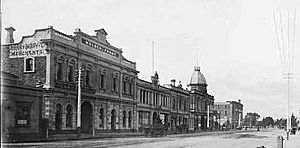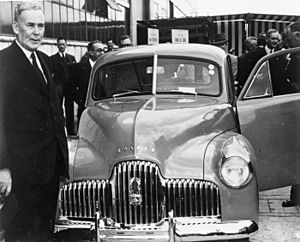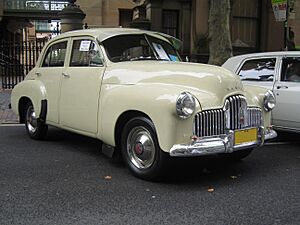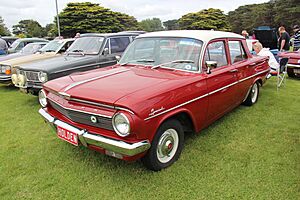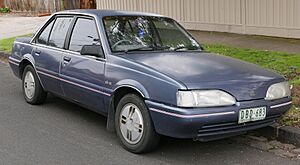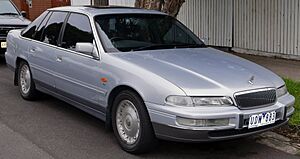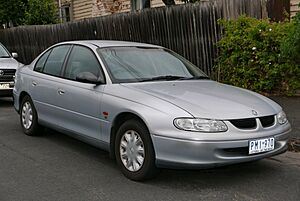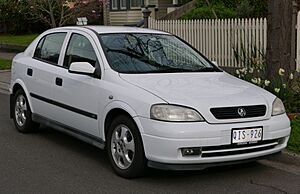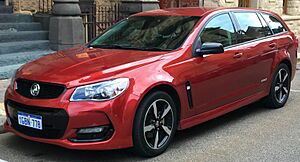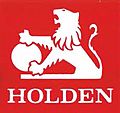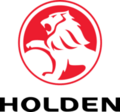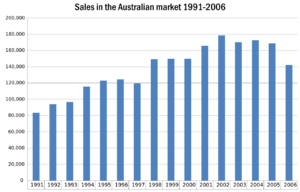Holden facts for kids
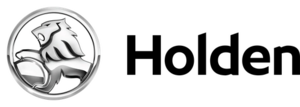 |
|
|
Trade name
|
Holden |
|---|---|
| Subsidiary | |
| Industry | Automotive |
| Fate | Holden marque discontinued; replaced by GM Specialty Vehicles |
| Successor | GM Specialty Vehicles |
| Founded | 1856 (as J. A. Holden & Co) in Adelaide, South Australia |
| Founders |
|
| Defunct | 1 January 2021 |
| Headquarters |
|
|
Area served
|
Australia & New Zealand |
|
Key people
|
|
| Products | Automobiles |
| Parent | General Motors |
| Divisions | Holden Special Vehicles (50%) |
Holden was a famous Australian car company. It was once known as General Motors-Holden. Holden was a part of the American company General Motors (GM).
It started in Adelaide, Australia, in 1856. Holden made, imported, and sold cars under its own name in Australia. Its main office was in Port Melbourne, with big factories in South Australia and Victoria.
For 164 years, Holden was a big name in Australian cars. But at the end of 2020, the company stopped selling cars. In its last three years, Holden only imported vehicles, it didn't make them in Australia anymore.
Holden was best known for its own cars, like the Holden Commodore, Holden Caprice, and the Holden Ute. But Holden also sold cars that were made by other companies. These cars were given a Holden badge. They came from Nissan, Suzuki, Toyota, Isuzu, and other GM brands like Opel, Vauxhall, and Chevrolet.
Contents
- History of Holden Cars
- How Holden Started
- Making Australia's Own Car (1940s)
- Dominating the Market (1950s)
- New Designs and Competition (1960s)
- Changing Times (1970s)
- Challenges and Changes (1980s)
- Growth and New Models (1990s)
- Challenges and Global Connections (2000s)
- The End of Australian Manufacturing (2010s)
- The End of the Holden Brand (2020s)
- Vehicles Made by Holden
- Holden's Logo and Brand
- Sales Performance
- Holden in Motorsport
- See also
History of Holden Cars
How Holden Started
In 1852, James Alexander Holden came to South Australia from England. In 1856, he started a business called J. A. Holden & Co.. They made saddles and other leather goods in Adelaide.
Later, in 1879, James's son, Henry James Holden, joined the company. In 1885, H. A. Frost became a partner, and the company changed its name to Holden & Frost Ltd..
Edward Holden, James's grandson, joined in 1905. He was very interested in cars. By 1908, Holden & Frost started doing small repairs on car seats. In 1914, they began building new car bodies for older car frames. They would mount the body, paint it, and finish the inside.
After 1917, during wartime, it was hard to import car parts. So, the company started making full car bodies. In 1919, H. J. Holden started a new company called Holden's Motor Body Builders Ltd (HMBB). They focused on making car bodies.
By 1923, HMBB was making 12,000 car bodies each year. They made bodies for many car brands. In 1924, HMBB became the only supplier of car bodies for GM in Australia.
In 1926, General Motors (Australia) Limited was set up. They had factories around Australia. These factories used car bodies from HMBB.
The Great Depression in 1930-1931 hit Holden hard. Car production dropped a lot. In 1931, GM bought HMBB. They combined it with General Motors (Australia) to form General Motors-Holden's Ltd (GM-H). This helped GM connect with Australian people.
Making Australia's Own Car (1940s)
Holden opened a second big car factory in Fishermans Bend (Port Melbourne) in 1936. But World War II stopped car production. Factories instead made things for the war, like vehicle bodies and aircraft parts.
After the war, the Australian government wanted to encourage a local car industry. GM decided to make the first Australian-designed car. The design was based on an old Chevrolet idea.
The first Holden car was launched in 1948. It was very popular, and people had to wait a long time to get one. The car was named "Holden" to honor Sir Edward Holden. It was officially called the "48-215" but was just known as the "Holden."
Dominating the Market (1950s)
In the 1950s, Holden was the biggest car seller in Australia. GM invested a lot of money to make more cars. This helped meet the high demand after the war.
In 1951, Holden started making the "ute" (short for utility vehicle). This car was very popular in Australian rural areas. In 1953, the "ute" and sedan were updated and called the FJ model. A new "panel van" style was also added. The FJ became a famous Australian car symbol.
Holden started exporting the FJ to New Zealand in 1954. By 1957, Holden cars were sold in 17 countries. In 1958, Holden had more than half of the Australian car market. They opened a new factory in Dandenong, Melbourne, in 1956. By 1959, Holden had 19,000 workers across the country.
New Designs and Competition (1960s)
In 1960, Holden launched the FB model. Its style was inspired by American cars, with tailfins. This look was already a bit old-fashioned when it came out. The FB was the first Holden made for countries that drive on the right side of the road. This helped with exports to places like Hawaii.
In 1960, Ford launched the new Falcon in Australia. It was a strong competitor. Holden responded with new models like the EK (1961) and EJ (1962). The EJ introduced the luxury Premier model.
In 1963, the EH came out with a new, more powerful engine called the "Red motor." In 1966, the HR was introduced. It was the first Australian car to have front seat belts as standard in all models. By 1963, Holden was exporting cars to many parts of the world.
Holden also started making smaller cars. In 1967, they launched the Holden Torana. This car was very popular in motor racing.
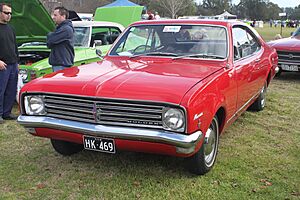
In 1968, Holden introduced the HK series. This was the first Holden to have a V8 engine. New models like the luxury Brougham and the two-door coupé, the Monaro, were also part of this series. The Monaro became a very popular car.
In 1969, Holden made its two-millionth car. Even with new competitors, Holden's large cars were still the best-selling vehicles in Australia.
Changing Times (1970s)
In 1971, Holden launched the new HQ series. At this time, all Holden passenger cars were designed and made in Australia. The HQ was a big change, with a new frame and suspension. It also introduced the new luxury Statesman brand. The HQ became the best-selling Holden ever, with over 485,000 cars sold in three years.
The HQ series was updated in 1974 with the HJ. Later, the HX and HZ series brought better handling and comfort.
The Torana continued to be developed. In 1974, the larger LH series Torana was released. It was special because it could use four, six, or eight-cylinder engines. The Torana had great success in Australian car races.
In 1975, Holden introduced the small Gemini. It was a popular car and sold very well.

Holden's most popular car, the Commodore, was launched in 1978. It was based on a European car design. The Commodore quickly became the top-selling car in Australia. Holden also exported many Commodores to countries like New Zealand and Thailand.
Holden stopped making the Torana in 1979.
Challenges and Changes (1980s)
The 1980s were tough for Holden. The Australian Government tried to help car makers by encouraging them to make fewer models but in larger numbers.
Holden started importing more cars from other GM companies. They brought in the Rodeo (a light truck) from Isuzu in Japan in 1980. Other imported cars included the Jackaroo (a four-wheel drive) and the Shuttle van.
In 1981, Holden's engine plant started making the "Family II" engine. This engine was used in cars in Australia and exported to Europe.
Sales of the Commodore also dropped. The Camira, released in 1982, initially sold well. But buyers thought its engine was too weak, and the car's quality was not great. The Camira only lasted seven years. This caused Holden to lose a lot of money.
In 1984, Holden updated the Commodore with the VK model. In 1986, the VL Commodore came out with new styling. This car used a Nissan engine because new rules required cars to use unleaded petrol. This decision was expensive for Holden.
GM helped Holden by paying off its debts in 1986. Holden was then reorganized. Car bodies were made in Elizabeth, and engines in Fishermans Bend. The engine business was very successful, making engines for cars built overseas.
In 1988, the VN Commodore was released. It was a much wider car and used a powerful American-designed engine.
Holden also started selling smaller cars like the Barina (1985) and the Holden Astra (1989). These were based on cars from Suzuki and Nissan. In 1989, Holden teamed up with Toyota to form United Australian Automobile Industries (UAAI). This meant Holden sold rebadged Toyotas, and Toyota sold a rebadged Commodore.
Growth and New Models (1990s)
In the 1990s, Holden's share of the Australian car market grew. They made Australia's best-selling car and exported many engines. Holden also started importing cars to offer a wider range of vehicles. In 1998, the company's name was shortened to "Holden Ltd."
In 1990, Holden brought back the Statesman and Caprice luxury models. These were based on the Commodore. In 1992, anti-lock brakes (ABS) were added to the Commodore range.
In 1997, Holden launched the all-new VT Commodore. This car had a new, rounded look and better handling. It was also safer in crashes. The VT Commodore was a big step forward for Holden.
The partnership with Toyota (UAAI) ended in 1996. Holden went back to selling only GM products. The Holden Astra and Vectra, designed by Opel in Germany, replaced the Toyota-based cars.
Challenges and Global Connections (2000s)
Holden's market share started to drop in the 2000s. Toyota became the number one car seller in Australia in 2003. Commodore sales also began to decline.
This drop in sales affected Holden's profits. The company lost money in several years. In 2005, "Holden Ltd" became "GM Holden Ltd."
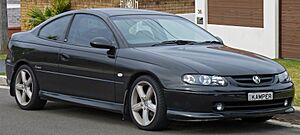
Holden brought back the Monaro coupe in 2001. It was based on the Commodore. This car became very popular around the world. It was sold in the UK as a Vauxhall Monaro and in the United States as the Pontiac GTO.
In 2004, Holden introduced the VZ model with a new "High Feature" engine. This engine was built at the Fishermans Bend factory.
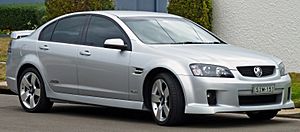
In 2006, Holden launched the all-new VE model. This was Holden's first completely new design since 1971. It was a very important car for the company.
To save money, Holden started using cars from the South Korean company Daewoo (which GM owned). The 2005 Holden Barina and the Viva were based on Daewoo models. The Captiva SUV also came from Daewoo in 2006.
In 2008, the Holden Rodeo was renamed the Colorado. This happened because GM and Isuzu separated.
In 2009, Holden announced it would import the Chevrolet Cruze small car from South Korea. Later, they planned to build it in Australia.
The End of Australian Manufacturing (2010s)
In 2012, the Australian government gave Holden money to help keep making cars in Australia until at least 2022. Holden also planned to invest a lot of money.
However, in 2013, Holden needed more money. The company was losing money on every car it made. They tried to cut costs, including reducing employee wages.
After not getting enough funding from the government, General Motors announced on December 11, 2013, that Holden would stop making engines and vehicles in Australia by the end of 2017. This meant about 2,900 jobs would be lost. After 2017, Holden would only sell imported cars.
In 2014, GM decided to keep the Lang Lang Proving Ground, a car testing track, in Australia.
On October 20, 2017, Holden stopped making cars in Australia. The Elizabeth factory closed. After this, Holden only imported cars from other GM companies around the world.
The End of the Holden Brand (2020s)
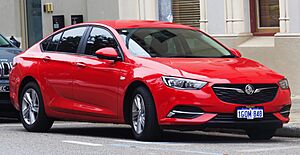
On February 17, 2020, General Motors announced that the Holden brand would be stopped by 2021. GM decided it would no longer make cars for countries that drive on the right side of the road. Holden had produced nearly 7.7 million vehicles in its history.
Holden has been replaced by GM Specialty Vehicles (GMSV). This new company imports cars like the Chevrolet Silverado and the Chevrolet Corvette into Australia.
Vehicles Made by Holden
Here are some of the cars Holden sold:
- Holden-designed models
- Holden Standard (1948–1968)
- Holden Utility (1948–2017)
- Holden 48-215-FJ (1948–1956)
- Holden Panel Van (1953–1969)
- Holden Premier (1962–1968)
- Holden Sandman (1974–1980)
- Holden Camira (1982–1989)
- Holden Statesman/Caprice (1990–2017)
- Holden Commodore/Berlina/Calais (1978–2017)
- Holden Adventra (2003-2006)
- Holden Crewman (2003-2006)
- Holden Ute (2000–2017)
- Holden Belmont/Kingswood/Premier (1968–1984)
- Holden Monaro (1968–1977; 2001–2005)
- Holden Sunbird/Torana (1967–1980)
- Statesman (1971–1984)
- Chevrolet-based models
- Holden Astra Sedan (2017–2019)
- Holden Barina (2011–2018)
- Holden Colorado (2008–2020)
- Holden Colorado 7/Trailblazer (2012–2020)
- Holden Cruze (2009–2016)
- Holden Malibu (2013–2016)
- Holden Spark (2009–2020)
- Holden Suburban (1998–2001)
- Holden Trax (2013–2020)
- Holden Volt (2012–2015)
- Holden Equinox (2018–2020)
- Daewoo-based models
- Holden Barina (2005–2011)
- Holden Captiva (2006–2018)
- Holden Epica (2007–2011)
- Holden Viva (2005–2009)
- GMC-based models
- Holden Acadia (2018–2020)
- Isuzu-based models
- Holden Frontera (1995–2004)
- Holden Gemini (1975–1986)
- Holden Jackaroo/Monterey (1981–2002)
- Holden Rodeo (1981–2008)
- Nissan-based models
- Holden Astra (1984–1989)
- Opel/Vauxhall-based models
- Holden Astra (1996–2009, 2015–2020)
- Holden Barina (1994–2005)
- Holden Calibra (1991–1998)
- Holden Cascada (2015–2017)
- Holden Combo (1996–2012)
- Holden Commodore (2018–2020)
- Holden Insignia (2015–2017)
- Holden Tigra (2005–2007)
- Holden Vectra (1997–2006)
- Holden Zafira (2001–2005)
- Suzuki-based models
- Holden Barina (1985–1994)
- Holden Cruze (2002–2006)
- Holden Drover
- Holden Scurry
- Toyota-based models
- Holden Apollo (1989–1996)
- Holden Nova (1989–1996)
Holden's Logo and Brand
| Vehicle sales | Units |
|---|---|
| Passenger vehicles | 104,848 |
| Light commercial vehicles | 33,554 |
| Sport utility vehicles | 11,091 |
| Total | 146,680 |
| Vehicle production | Units |
| Total | 107,795 |
| Engine production | Units |
| Family II | 136,699 |
| High Feature | 132,722 |
| Total | 269,421 |
| Exports | Units |
| Engines | 173,463 |
| Vehicles | 36,534 |
| Total | 209,997 |
Holden's logo is a lion holding a stone. It was first used in 1928. The design comes from an old story about lions rolling stones, which supposedly led to the idea of the wheel. The logo was updated several times over the years.
In 1987, Holden started Holden Special Vehicles (HSV). This company made special, high-performance versions of Holden cars.
In 2010, Holden sold cars through a network of 310 stores across Australia. More than 13,500 people worked for Holden.
Exports to Other Countries
Holden started exporting cars in 1954, sending the FJ model to New Zealand. To sell more cars overseas, Holden made its Commodore, Monaro, and Statesman/Caprice models for both left-hand and right-hand drive markets.
The Middle East was Holden's biggest export market. The Commodore was sold there as the Chevrolet Lumina. The Statesman was sold as the Chevrolet Caprice. Commodores were also sold in other countries like Brazil (as the Chevrolet Omega).
From 2008 to 2009, the G8 in North America was actually a Holden Commodore sedan. The Monaro coupe was also sold in the United States as the Pontiac GTO and in the United Kingdom as the Vauxhall Monaro.
Holden's exports became very profitable. From 1999 to 2006, the money from exports grew a lot.
Later, from 2011, the WM Caprice was exported to North America. It was sold as the Chevrolet Caprice PPV, a special version for police. From 2007, the HSV-based Commodore was sold in the UK as the Vauxhall VXR8.
In 2013, Chevrolet announced that the VF Commodore would be exported to North America as the Chevrolet SS sedan. This car was sold in the United States until 2017.
Sales Performance
Holden used to be the top car seller in Australia. But in the 21st century, their sales went down. This was partly because sales of the Commodore dropped.
| Year | Annual sales | Position | Best selling model |
|---|---|---|---|
| 2002 | 178,392 | 1 | Commodore |
| 2003 | 175,412 | 2 | Commodore |
| 2004 | 178,027 | 2 | Commodore |
| 2005 | 174,464 | 2 | Commodore |
| 2006 | 146,511 | 2 | Commodore |
| 2007 | 146,680 | 2 | Commodore |
| 2008 | 130,338 | 2 | Commodore |
| 2009 | 119,568 | 2 | Commodore |
| 2010 | 132,923 | 2 | Commodore |
| 2011 | 126,095 | 2 | Commodore |
| 2012 | 114,665 | 2 | Commodore |
| 2013 | 112,059 | 2 | Commodore |
| 2014 | 106,092 | 2 | Commodore |
| 2015 | 102,951 | 3 | Commodore |
| 2016 | 94,308 | 4 | Commodore |
| 2017 | 90,306 | 4 | Commodore |
| 2018 | 60,754 | 6 | Colorado |
| 2019 | 43,176 | 10 | Colorado |
| 2020 | 16,688 | Colorado |
| Year | Annual sales | Position | Best selling model |
|---|---|---|---|
| 2002 | Commodore | ||
| 2003 | Commodore | ||
| 2004 | Commodore | ||
| 2005 | Commodore | ||
| 2006 | Commodore | ||
| 2007 | Commodore | ||
| 2008 | Commodore | ||
| 2009 | Commodore | ||
| 2010 | Commodore | ||
| 2011 | Commodore | ||
| 2012 | 3 | Captiva | |
| 2013 | 11,722 | 3 | Commodore |
| 2014 | 13,422 | 3 | Commodore |
| 2015 | 2 | Colorado | |
| 2016 | 3 | Colorado | |
| 2017 | 3 | Colorado | |
| 2018 | 13,046 | 3 | Colorado |
Holden in Motorsport
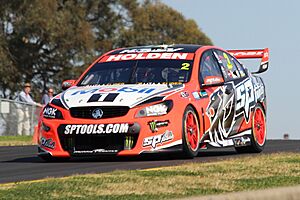
Holden was very involved in Australian car racing since 1968. Their main factory-backed teams were the Holden Dealer Team and the Holden Racing Team.
As of 2015, Holden had won the famous Bathurst 1000 race 30 times. This was more than any other car maker. They also won the Australian Touring Car and Supercars Championship titles 21 times. Many racing teams continued to use Holden Commodores in races even after the brand stopped making cars.
See also
 In Spanish: Holden para niños
In Spanish: Holden para niños


